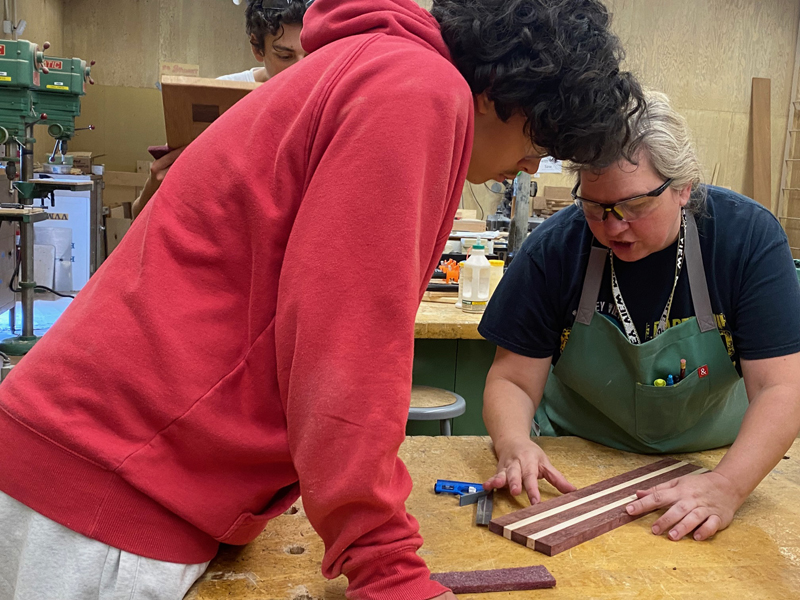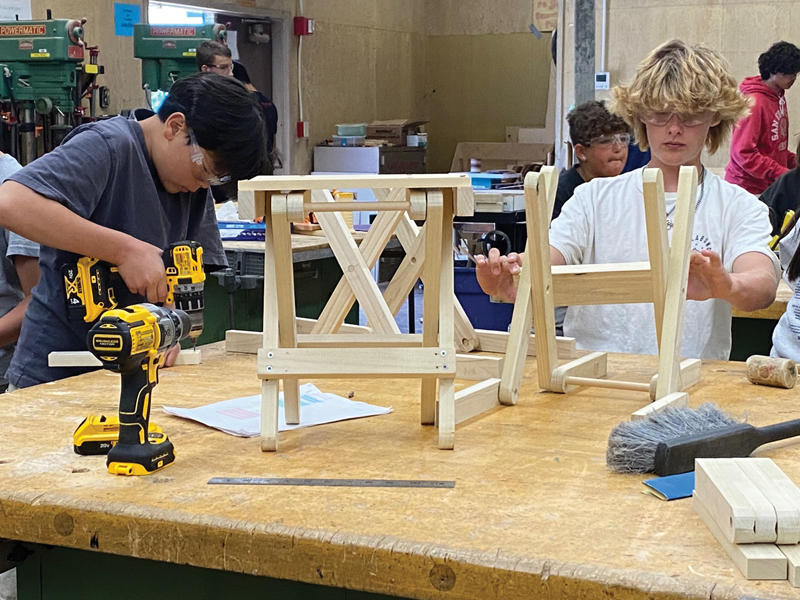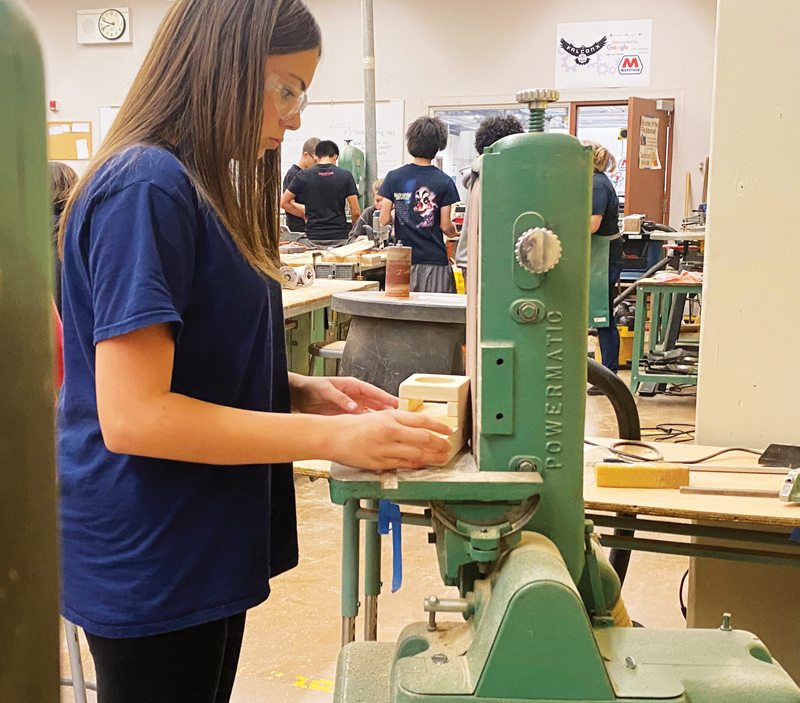Kids craft cool creations in new generation woodshop

PLEASANT HILL, CA (August 23, 2024) — In the current educational era of STEM and STEAM, a handful of local middle school educators are turning back the clock to revitalize the time-tested woodshop classes for a new generation of students.
For their parents, but more likely grandparents who graduated in the 1960s, 1970s or 1980s, those bygone days in the industrial arts elective classes produced projects ranging from the simple birdhouses and picture frames to more complex projects like cutting boards, desk drawer organizers and chess tables that combined different types of woods. At the same time, those projects were unknowingly garnering vital problem-solving and critical thinking skills that are buzz words in today’s classrooms.
Call it Woodshop 2.0.

Teachers who are reinvigorating this elective option for today’s middle schoolers at a few sites around the Mt. Diablo Unified School District, see the opportunity as two-fold.
Providing both a wholly new and old hands-on experience for their students, while also introducing potential new career paths for them as they prepare for high school and the period afterwards that may not necessarily include college, but the vocational trades.
“You cannot get more STEM than actually building and creating stuff,” said Jim Bergmann, who teaches woodshop at Sequoia Middle School in Pleasant Hill.
Prior to embarking on his efforts to revamp the woodshop offering at Sequoia, the classroom and its equipment sat idle for several years. Since the school’s inception in 1967, there had been six woodshop teachers.
When all the rage was about setting up computer labs in the early 2000s to complement growing technology curriculums, woodshops were switched for a new purpose. Then when schools invested in portable laptops and Chromebooks that could be stored and charged in rolling boxes in classrooms, the woodshops of old basically became storage rooms for these obsolete desktop computers.
Fast forward to the new 2024-25 school year, Bergmann’s third year at the helm of Sequoia’s program after moving up from teaching fifth grade, he is committed to bringing back the traditional wood-working experience.
“I gave myself five years to get the shop up and running to the way I wanted,” he said, recalling many recent summers when he worked several hours a day, up to five days-a-week, repairing equipment that had fallen into disrepair due to a lack of usage.
“After you breathe life back into it, for me it is about getting tools in kids’ hands,” Bergmann added.
Allowing kids to make mistakes is part of the learning process in his classroom, as is having pride in making something.
Two better than one

Bergmann attributes the bright outlook for the future of his woodshop to the collaboration forged with Nicole Manasewitsch, who has been similarly working to revitalize her program at Valley View Middle School.
Through her outreach efforts to the community, the two area woodshop programs have gained financial support from service clubs – like the Pleasant Hill Rotary – to acquire items like six skills saws as well as badly needed donations of spare wood from the commercial establishments like Golden State Lumber.
“Not only do we share curriculum, resources and ideas, but this year we hope to do a pinewood derby challenge between our schools,” said Manasewitsch, who embarks on her second year of teaching woodshop this upcoming school year.
Also instrumental have been the Diablo Woodworkers, which supports the MDUSD Adult Ed program, which she said, “have been paramount in supporting the revitalization of our shop program.”
Her love of woodworking was instilled in her as a middle school student under the tutelage of Don DuPont, which led to her taking it for three years.
“I was bummed to discover that my high school did not offer a woodworking course and many schools at the time were losing a lot of their hands-on courses,” said Manasewitsch.
Coincidentally, she noted having reconnected with DuPont, who has served as a mentor to her and has continued to lend his assistance in her woodshop throughout the school year.
“In my 19 years of teaching, I have seen students’ joy for learning fade. Students should enjoy coming to school. They should be excited to share what they learned in their day with others,” she said. “We need to offer programs and activities which ignite students’ love for learning. We need to give them programs that spark their interest and make them want to come to school. Almost everyone out there, who has ever taken a shop class, typically still has one of their projects at home.”In providing this elective, Manasewitsch hopes it’s an outlet that sparks consideration in other post high school career interests.
“Trade careers are really in need of a workforce. Numbers have been dwindling as our young people have had less exposure to non-college career options. More importantly though, hands-on courses like shop, allow our young people to learn transferrable skills that are useful in life – like home or car maintenance,” she said.
Help from others
Bergmann noted the financial support for his efforts have come from Local 342 Steam Fitters, the Sequoia PTA, as well as friends, who themselves gained success in the trades by product of their own positive woodshop experiences.
Working side-by-side with his dad, who volunteers in his classroom several days a week, has been invaluable.
The knowledge Bergmann now imparts to his students, was instilled by his father.
“It shows these skills are generational,” he said. “I am grateful to have my dad there.”
And, with 37 kids in the classroom, just having another set of well-skilled eyes and a common voice is highly beneficial for the younger Bergmann.
“Mr. Bergmann said the same thing as Mr. Bergmann said, so maybe we should do it,” he recalled hearing his students say.
Looking ahead to the coming school year, he recalled what he always shares with the parents at the annual back-to-school night gathering.
“If my name is not mentioned as your children’s favorite teacher by the end of school year, I have not worked hard enough,” he said. “I want to create those long-lasting memories and help the students to not be afraid of tools and know how to use them safely.”

David Scholz
David Scholz is back in journalism as a freelance writer and photographer after nearly two decades in education. Prior to moving into teaching in 2000, he worked as a full-time journalist since 1988 for rural community and small daily newspapers in Central Ohio and Northern Nevada, and later in California with The Business Journal in Fresno and dailies in the Bay Area, including The Oakland Tribune and The San Francisco Chronicle. More recently Scholz also worked in an editing, writing, and page layout role with the Rossmoor News.
